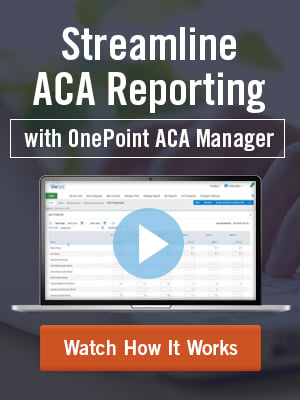ACA Compliance Changes for 2016 | OnePoint HCM

Think your ACA troubles are over? Think again!
Stricter ACA reporting requirements with more employers required to comply
 ACA reporting for 2015 was definitely a learning experience for applicable large employers (ALE), health insurance carriers and even the IRS. 2016 will present similar complications for a whole new set of employers, as the reporting requirements expand to include mid-sized organizations. This year employers with 50-99 full-time workers are required to offer the minimum affordable coverage to their employees; and therefore will be obligated to comply with filing deadlines.
ACA reporting for 2015 was definitely a learning experience for applicable large employers (ALE), health insurance carriers and even the IRS. 2016 will present similar complications for a whole new set of employers, as the reporting requirements expand to include mid-sized organizations. This year employers with 50-99 full-time workers are required to offer the minimum affordable coverage to their employees; and therefore will be obligated to comply with filing deadlines.
Large employers can’t be complacent with ACA either. With one year of reporting done, large employers can expect that there will be less leniency from the IRS on filing issues and errors. In addition, the transitional rules in place to ease ACA implementation for employers has sunset. This increases the threshold of full-time employees that must be offered a minimum value coverage from 70% to 95%.
2016 ACA compliance changes you need to know
Mid-Sized Employer Transitional Relief Expires–In 2015, there was some transitional relief that exempted most mid-sized employers from being subjected to employer mandate penalties. This transitional relief expires in 2016, so both mid-sized and large employers will be subject to employer mandate penalties attributable to 2016.
Counting Employee Transitional Relief Expires–In 2015, employers were permitted to determine their total number of full-time equivalent employees by averaging any consecutive 6-month period in 2014. However, in 2016, the employer will be required to average their FTEs for all 12 months in 2015 to determine if they are required to comply with the mandate.
Employer Mandate Margin of Error Shrinks–In 2015, large employers could fail to offer coverage to up to 30% of their full-time employees and still not face employer mandate penalties. In 2016, the margin of error shrinks to 5%. So in 2016 and beyond, both large and mid-sized employers will be required to offer coverage to 95% of their full-time employees or face a penalty.
Employer Mandate Penalty Calculation Changes–In 2015, when calculating the "A" or "no coverage" penalty, large employers could subtract out their first 80 full-time employees. In 2016 and beyond, both mid-sized and large employers may subtract out only their first 30 full-time employees when calculating the "A" penalty.
2015 Lessons Learned
What are the lessons learned from the initial reporting year? While there were of course technical challenges with filing, compounded by confusion on filing deadlines, the biggest pitfall of reporting was collecting the data. Reconciling timekeeping, payroll and benefits data for full-time employees was harder and a more time consuming process than had been predicted.
Planning and preparation is a major part of ACA compliance. But there is still uncertainty when assessing strategy for combining Benefits, Payroll and Timekeeping data for ACA filing. Having a reliable and accurate employee time tracking system is necessary to track service hours for measurement and stability periods. But what about payroll and benefits data? If you don't have all three pieces in one place, how much time is it going to take to consolidate data? What is the audit plan to make sure data moving from one system to another is accurate? How long is it going to take to audit to ensure your filings are correct?
Taking the right steps now to implement the right time tracking measures can be crucial for many businesses that are required to comply with ACA for 2016. OnePoint HCM offers one seamless database uniting HR, time, benefits and payroll data into a comprehensive ACA Compliance management solution.
Subscribe to updates
Get the latest posts delivered to your inbox.